Project Management Process for Digital Transformation at Click-It
VerifiedAdded on 2023/04/25
|10
|2197
|268
Report
AI Summary
This report outlines the Standard Operating Procedures (SOP) for Click-It Photography Company, a small business undergoing digital transformation. It details guidelines for various project management activities, including scope, cost, risk, schedule, quality, resource, communication, stakeholder, procurement, and integration management. The SOP includes standard forms, templates, and checklists for effective project execution. The project will be conducted in five phases: initiation, planning, execution, control, and closure. Implementation involves training and development for employees and stakeholders on new digital tools and platforms, followed by reviews to gather feedback and improve project processes and outcomes. The integration of all project management components is crucial for streamlining tasks and activities, ensuring improved performance through training, development, and follow-up reviews. Desklib provides access to similar solved assignments and past papers for students.
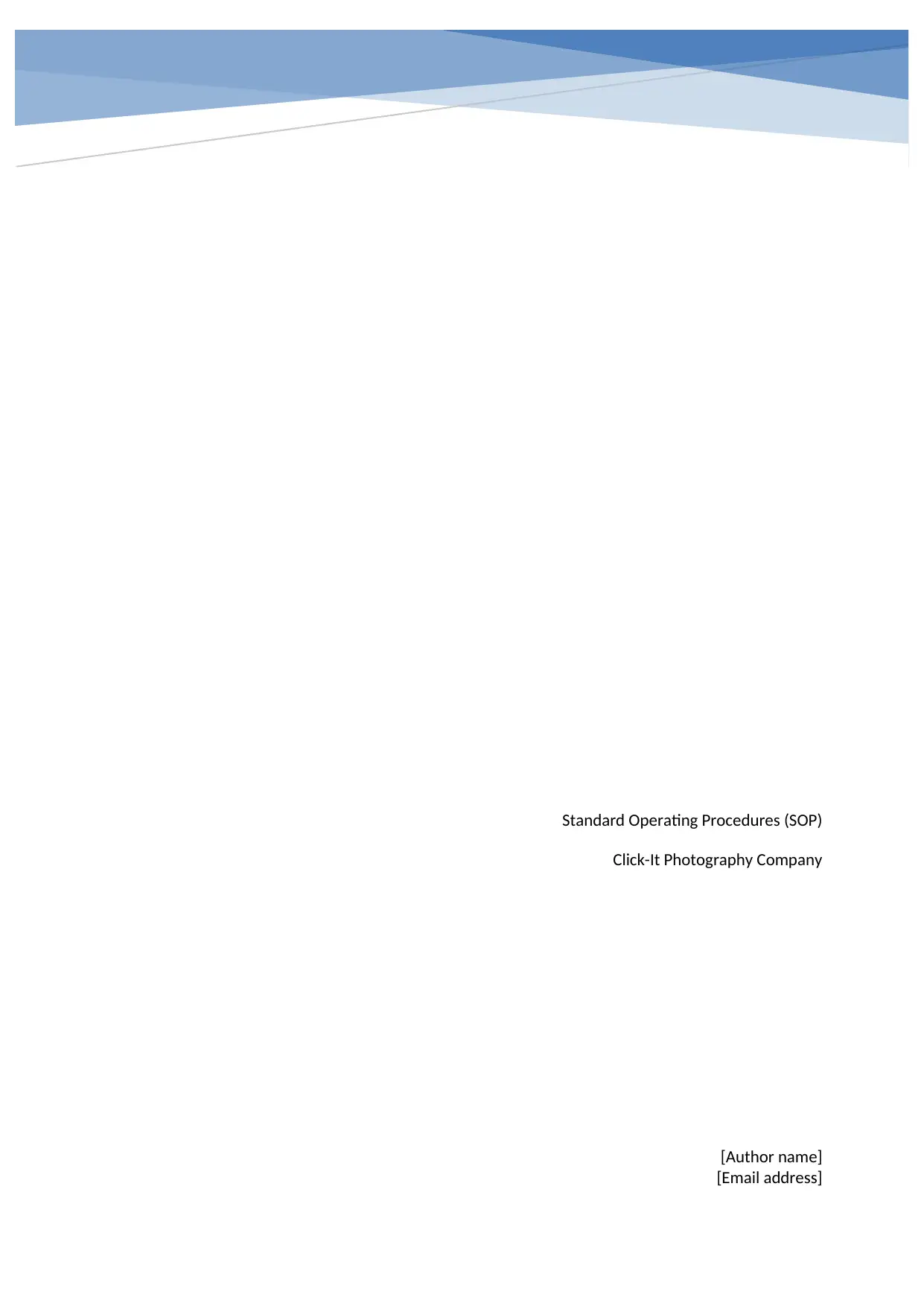
Standard Operating Procedures (SOP)
Click-It Photography Company
[Author name]
[Email address]
Click-It Photography Company
[Author name]
[Email address]
Paraphrase This Document
Need a fresh take? Get an instant paraphrase of this document with our AI Paraphraser
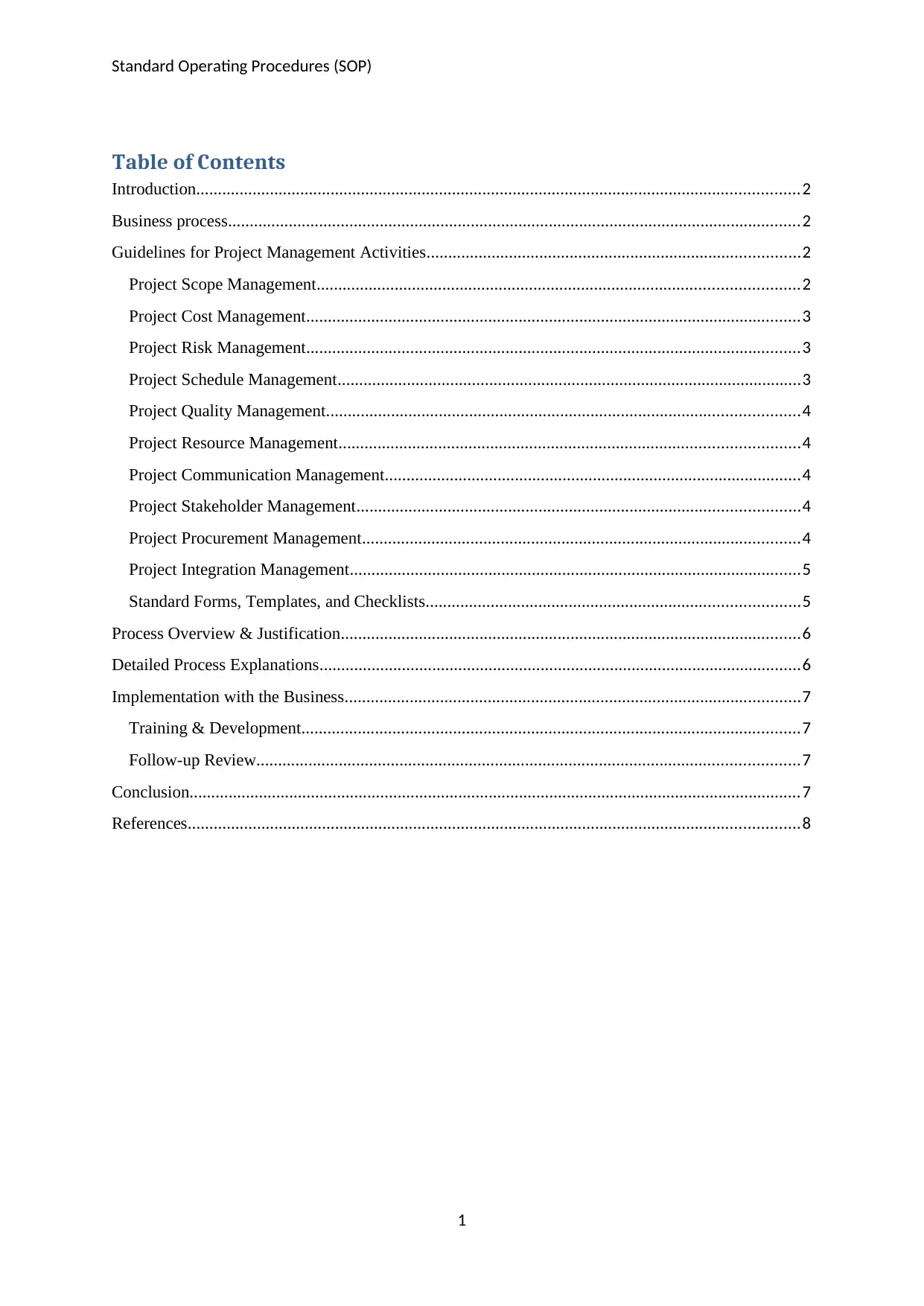
Standard Operating Procedures (SOP)
Table of Contents
Introduction...........................................................................................................................................2
Business process....................................................................................................................................2
Guidelines for Project Management Activities......................................................................................2
Project Scope Management...............................................................................................................2
Project Cost Management..................................................................................................................3
Project Risk Management..................................................................................................................3
Project Schedule Management...........................................................................................................3
Project Quality Management.............................................................................................................4
Project Resource Management..........................................................................................................4
Project Communication Management................................................................................................4
Project Stakeholder Management......................................................................................................4
Project Procurement Management.....................................................................................................4
Project Integration Management........................................................................................................5
Standard Forms, Templates, and Checklists......................................................................................5
Process Overview & Justification..........................................................................................................6
Detailed Process Explanations...............................................................................................................6
Implementation with the Business.........................................................................................................7
Training & Development...................................................................................................................7
Follow-up Review.............................................................................................................................7
Conclusion.............................................................................................................................................7
References.............................................................................................................................................8
1
Table of Contents
Introduction...........................................................................................................................................2
Business process....................................................................................................................................2
Guidelines for Project Management Activities......................................................................................2
Project Scope Management...............................................................................................................2
Project Cost Management..................................................................................................................3
Project Risk Management..................................................................................................................3
Project Schedule Management...........................................................................................................3
Project Quality Management.............................................................................................................4
Project Resource Management..........................................................................................................4
Project Communication Management................................................................................................4
Project Stakeholder Management......................................................................................................4
Project Procurement Management.....................................................................................................4
Project Integration Management........................................................................................................5
Standard Forms, Templates, and Checklists......................................................................................5
Process Overview & Justification..........................................................................................................6
Detailed Process Explanations...............................................................................................................6
Implementation with the Business.........................................................................................................7
Training & Development...................................................................................................................7
Follow-up Review.............................................................................................................................7
Conclusion.............................................................................................................................................7
References.............................................................................................................................................8
1
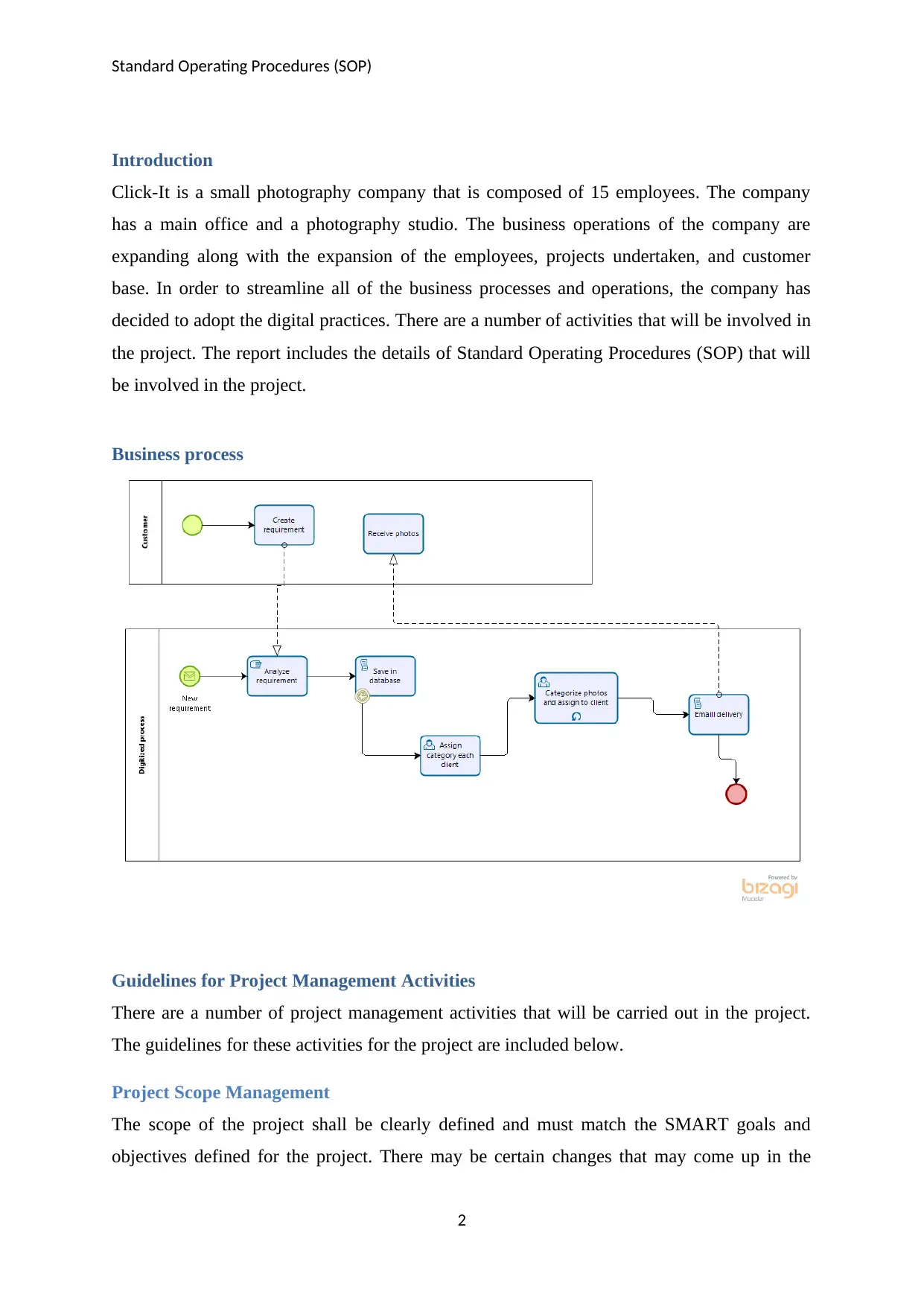
Standard Operating Procedures (SOP)
Introduction
Click-It is a small photography company that is composed of 15 employees. The company
has a main office and a photography studio. The business operations of the company are
expanding along with the expansion of the employees, projects undertaken, and customer
base. In order to streamline all of the business processes and operations, the company has
decided to adopt the digital practices. There are a number of activities that will be involved in
the project. The report includes the details of Standard Operating Procedures (SOP) that will
be involved in the project.
Business process
Guidelines for Project Management Activities
There are a number of project management activities that will be carried out in the project.
The guidelines for these activities for the project are included below.
Project Scope Management
The scope of the project shall be clearly defined and must match the SMART goals and
objectives defined for the project. There may be certain changes that may come up in the
2
Introduction
Click-It is a small photography company that is composed of 15 employees. The company
has a main office and a photography studio. The business operations of the company are
expanding along with the expansion of the employees, projects undertaken, and customer
base. In order to streamline all of the business processes and operations, the company has
decided to adopt the digital practices. There are a number of activities that will be involved in
the project. The report includes the details of Standard Operating Procedures (SOP) that will
be involved in the project.
Business process
Guidelines for Project Management Activities
There are a number of project management activities that will be carried out in the project.
The guidelines for these activities for the project are included below.
Project Scope Management
The scope of the project shall be clearly defined and must match the SMART goals and
objectives defined for the project. There may be certain changes that may come up in the
2
⊘ This is a preview!⊘
Do you want full access?
Subscribe today to unlock all pages.

Trusted by 1+ million students worldwide
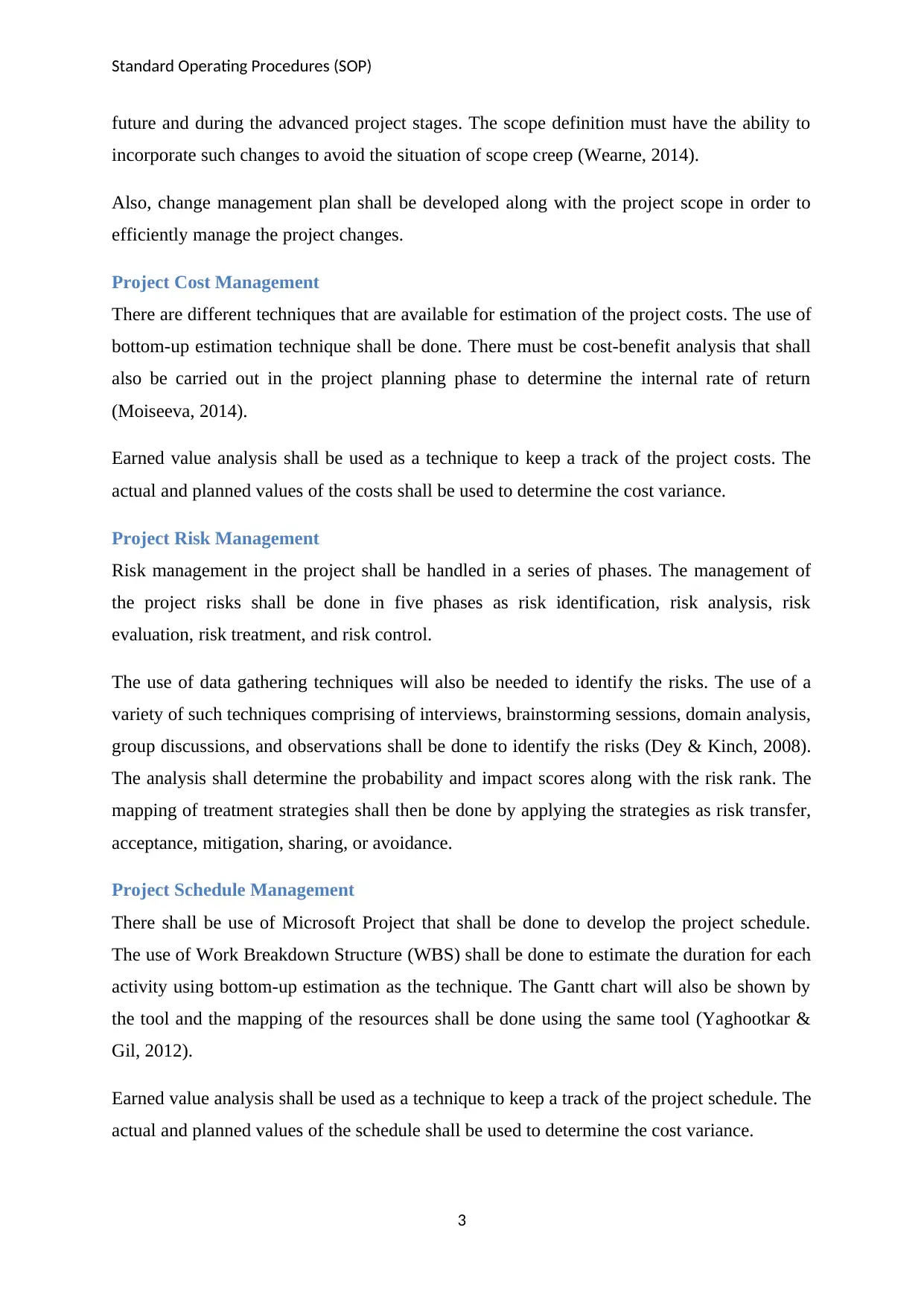
Standard Operating Procedures (SOP)
future and during the advanced project stages. The scope definition must have the ability to
incorporate such changes to avoid the situation of scope creep (Wearne, 2014).
Also, change management plan shall be developed along with the project scope in order to
efficiently manage the project changes.
Project Cost Management
There are different techniques that are available for estimation of the project costs. The use of
bottom-up estimation technique shall be done. There must be cost-benefit analysis that shall
also be carried out in the project planning phase to determine the internal rate of return
(Moiseeva, 2014).
Earned value analysis shall be used as a technique to keep a track of the project costs. The
actual and planned values of the costs shall be used to determine the cost variance.
Project Risk Management
Risk management in the project shall be handled in a series of phases. The management of
the project risks shall be done in five phases as risk identification, risk analysis, risk
evaluation, risk treatment, and risk control.
The use of data gathering techniques will also be needed to identify the risks. The use of a
variety of such techniques comprising of interviews, brainstorming sessions, domain analysis,
group discussions, and observations shall be done to identify the risks (Dey & Kinch, 2008).
The analysis shall determine the probability and impact scores along with the risk rank. The
mapping of treatment strategies shall then be done by applying the strategies as risk transfer,
acceptance, mitigation, sharing, or avoidance.
Project Schedule Management
There shall be use of Microsoft Project that shall be done to develop the project schedule.
The use of Work Breakdown Structure (WBS) shall be done to estimate the duration for each
activity using bottom-up estimation as the technique. The Gantt chart will also be shown by
the tool and the mapping of the resources shall be done using the same tool (Yaghootkar &
Gil, 2012).
Earned value analysis shall be used as a technique to keep a track of the project schedule. The
actual and planned values of the schedule shall be used to determine the cost variance.
3
future and during the advanced project stages. The scope definition must have the ability to
incorporate such changes to avoid the situation of scope creep (Wearne, 2014).
Also, change management plan shall be developed along with the project scope in order to
efficiently manage the project changes.
Project Cost Management
There are different techniques that are available for estimation of the project costs. The use of
bottom-up estimation technique shall be done. There must be cost-benefit analysis that shall
also be carried out in the project planning phase to determine the internal rate of return
(Moiseeva, 2014).
Earned value analysis shall be used as a technique to keep a track of the project costs. The
actual and planned values of the costs shall be used to determine the cost variance.
Project Risk Management
Risk management in the project shall be handled in a series of phases. The management of
the project risks shall be done in five phases as risk identification, risk analysis, risk
evaluation, risk treatment, and risk control.
The use of data gathering techniques will also be needed to identify the risks. The use of a
variety of such techniques comprising of interviews, brainstorming sessions, domain analysis,
group discussions, and observations shall be done to identify the risks (Dey & Kinch, 2008).
The analysis shall determine the probability and impact scores along with the risk rank. The
mapping of treatment strategies shall then be done by applying the strategies as risk transfer,
acceptance, mitigation, sharing, or avoidance.
Project Schedule Management
There shall be use of Microsoft Project that shall be done to develop the project schedule.
The use of Work Breakdown Structure (WBS) shall be done to estimate the duration for each
activity using bottom-up estimation as the technique. The Gantt chart will also be shown by
the tool and the mapping of the resources shall be done using the same tool (Yaghootkar &
Gil, 2012).
Earned value analysis shall be used as a technique to keep a track of the project schedule. The
actual and planned values of the schedule shall be used to determine the cost variance.
3
Paraphrase This Document
Need a fresh take? Get an instant paraphrase of this document with our AI Paraphraser
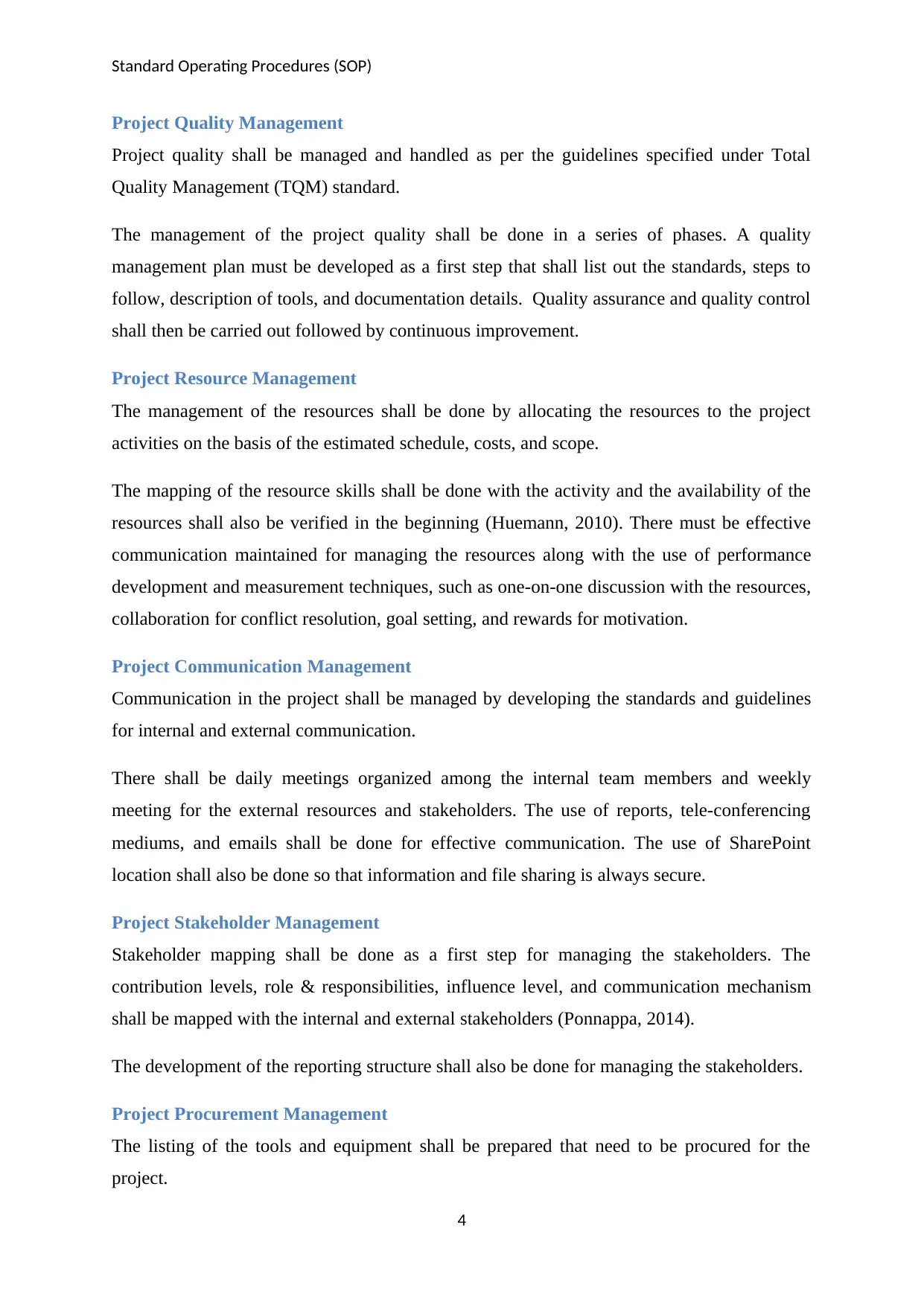
Standard Operating Procedures (SOP)
Project Quality Management
Project quality shall be managed and handled as per the guidelines specified under Total
Quality Management (TQM) standard.
The management of the project quality shall be done in a series of phases. A quality
management plan must be developed as a first step that shall list out the standards, steps to
follow, description of tools, and documentation details. Quality assurance and quality control
shall then be carried out followed by continuous improvement.
Project Resource Management
The management of the resources shall be done by allocating the resources to the project
activities on the basis of the estimated schedule, costs, and scope.
The mapping of the resource skills shall be done with the activity and the availability of the
resources shall also be verified in the beginning (Huemann, 2010). There must be effective
communication maintained for managing the resources along with the use of performance
development and measurement techniques, such as one-on-one discussion with the resources,
collaboration for conflict resolution, goal setting, and rewards for motivation.
Project Communication Management
Communication in the project shall be managed by developing the standards and guidelines
for internal and external communication.
There shall be daily meetings organized among the internal team members and weekly
meeting for the external resources and stakeholders. The use of reports, tele-conferencing
mediums, and emails shall be done for effective communication. The use of SharePoint
location shall also be done so that information and file sharing is always secure.
Project Stakeholder Management
Stakeholder mapping shall be done as a first step for managing the stakeholders. The
contribution levels, role & responsibilities, influence level, and communication mechanism
shall be mapped with the internal and external stakeholders (Ponnappa, 2014).
The development of the reporting structure shall also be done for managing the stakeholders.
Project Procurement Management
The listing of the tools and equipment shall be prepared that need to be procured for the
project.
4
Project Quality Management
Project quality shall be managed and handled as per the guidelines specified under Total
Quality Management (TQM) standard.
The management of the project quality shall be done in a series of phases. A quality
management plan must be developed as a first step that shall list out the standards, steps to
follow, description of tools, and documentation details. Quality assurance and quality control
shall then be carried out followed by continuous improvement.
Project Resource Management
The management of the resources shall be done by allocating the resources to the project
activities on the basis of the estimated schedule, costs, and scope.
The mapping of the resource skills shall be done with the activity and the availability of the
resources shall also be verified in the beginning (Huemann, 2010). There must be effective
communication maintained for managing the resources along with the use of performance
development and measurement techniques, such as one-on-one discussion with the resources,
collaboration for conflict resolution, goal setting, and rewards for motivation.
Project Communication Management
Communication in the project shall be managed by developing the standards and guidelines
for internal and external communication.
There shall be daily meetings organized among the internal team members and weekly
meeting for the external resources and stakeholders. The use of reports, tele-conferencing
mediums, and emails shall be done for effective communication. The use of SharePoint
location shall also be done so that information and file sharing is always secure.
Project Stakeholder Management
Stakeholder mapping shall be done as a first step for managing the stakeholders. The
contribution levels, role & responsibilities, influence level, and communication mechanism
shall be mapped with the internal and external stakeholders (Ponnappa, 2014).
The development of the reporting structure shall also be done for managing the stakeholders.
Project Procurement Management
The listing of the tools and equipment shall be prepared that need to be procured for the
project.
4
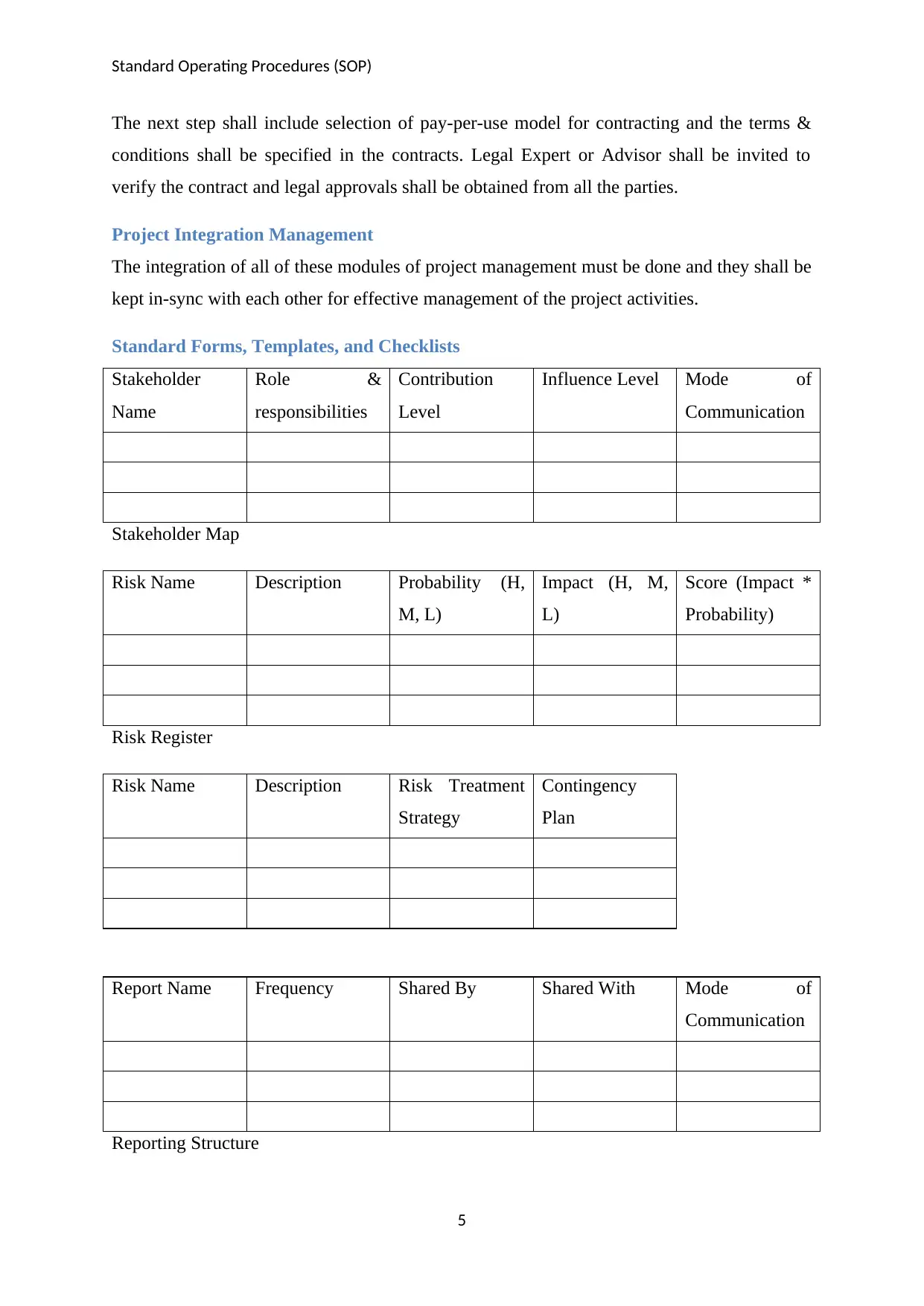
Standard Operating Procedures (SOP)
The next step shall include selection of pay-per-use model for contracting and the terms &
conditions shall be specified in the contracts. Legal Expert or Advisor shall be invited to
verify the contract and legal approvals shall be obtained from all the parties.
Project Integration Management
The integration of all of these modules of project management must be done and they shall be
kept in-sync with each other for effective management of the project activities.
Standard Forms, Templates, and Checklists
Stakeholder
Name
Role &
responsibilities
Contribution
Level
Influence Level Mode of
Communication
Stakeholder Map
Risk Name Description Probability (H,
M, L)
Impact (H, M,
L)
Score (Impact *
Probability)
Risk Register
Risk Name Description Risk Treatment
Strategy
Contingency
Plan
Report Name Frequency Shared By Shared With Mode of
Communication
Reporting Structure
5
The next step shall include selection of pay-per-use model for contracting and the terms &
conditions shall be specified in the contracts. Legal Expert or Advisor shall be invited to
verify the contract and legal approvals shall be obtained from all the parties.
Project Integration Management
The integration of all of these modules of project management must be done and they shall be
kept in-sync with each other for effective management of the project activities.
Standard Forms, Templates, and Checklists
Stakeholder
Name
Role &
responsibilities
Contribution
Level
Influence Level Mode of
Communication
Stakeholder Map
Risk Name Description Probability (H,
M, L)
Impact (H, M,
L)
Score (Impact *
Probability)
Risk Register
Risk Name Description Risk Treatment
Strategy
Contingency
Plan
Report Name Frequency Shared By Shared With Mode of
Communication
Reporting Structure
5
⊘ This is a preview!⊘
Do you want full access?
Subscribe today to unlock all pages.

Trusted by 1+ million students worldwide
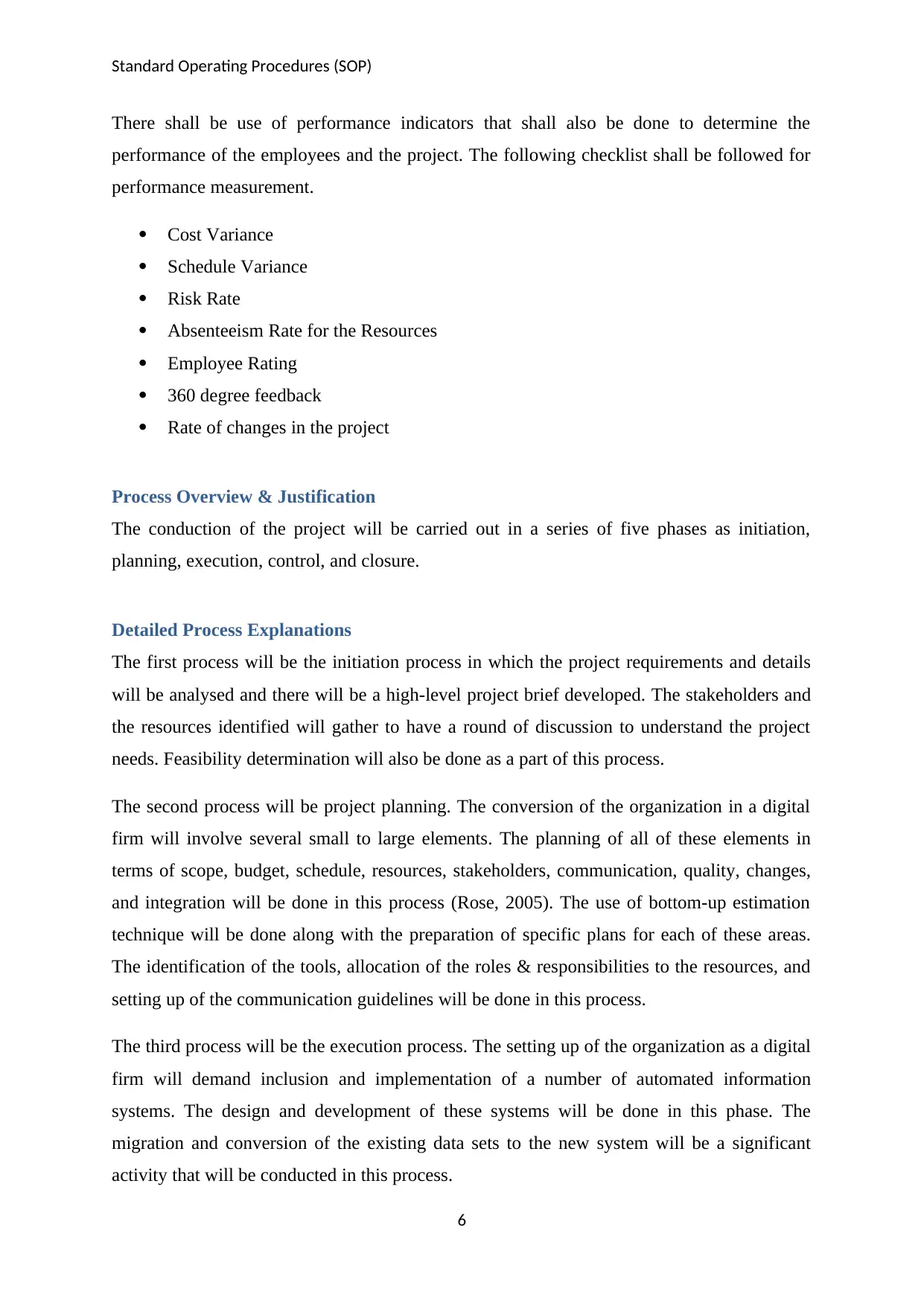
Standard Operating Procedures (SOP)
There shall be use of performance indicators that shall also be done to determine the
performance of the employees and the project. The following checklist shall be followed for
performance measurement.
Cost Variance
Schedule Variance
Risk Rate
Absenteeism Rate for the Resources
Employee Rating
360 degree feedback
Rate of changes in the project
Process Overview & Justification
The conduction of the project will be carried out in a series of five phases as initiation,
planning, execution, control, and closure.
Detailed Process Explanations
The first process will be the initiation process in which the project requirements and details
will be analysed and there will be a high-level project brief developed. The stakeholders and
the resources identified will gather to have a round of discussion to understand the project
needs. Feasibility determination will also be done as a part of this process.
The second process will be project planning. The conversion of the organization in a digital
firm will involve several small to large elements. The planning of all of these elements in
terms of scope, budget, schedule, resources, stakeholders, communication, quality, changes,
and integration will be done in this process (Rose, 2005). The use of bottom-up estimation
technique will be done along with the preparation of specific plans for each of these areas.
The identification of the tools, allocation of the roles & responsibilities to the resources, and
setting up of the communication guidelines will be done in this process.
The third process will be the execution process. The setting up of the organization as a digital
firm will demand inclusion and implementation of a number of automated information
systems. The design and development of these systems will be done in this phase. The
migration and conversion of the existing data sets to the new system will be a significant
activity that will be conducted in this process.
6
There shall be use of performance indicators that shall also be done to determine the
performance of the employees and the project. The following checklist shall be followed for
performance measurement.
Cost Variance
Schedule Variance
Risk Rate
Absenteeism Rate for the Resources
Employee Rating
360 degree feedback
Rate of changes in the project
Process Overview & Justification
The conduction of the project will be carried out in a series of five phases as initiation,
planning, execution, control, and closure.
Detailed Process Explanations
The first process will be the initiation process in which the project requirements and details
will be analysed and there will be a high-level project brief developed. The stakeholders and
the resources identified will gather to have a round of discussion to understand the project
needs. Feasibility determination will also be done as a part of this process.
The second process will be project planning. The conversion of the organization in a digital
firm will involve several small to large elements. The planning of all of these elements in
terms of scope, budget, schedule, resources, stakeholders, communication, quality, changes,
and integration will be done in this process (Rose, 2005). The use of bottom-up estimation
technique will be done along with the preparation of specific plans for each of these areas.
The identification of the tools, allocation of the roles & responsibilities to the resources, and
setting up of the communication guidelines will be done in this process.
The third process will be the execution process. The setting up of the organization as a digital
firm will demand inclusion and implementation of a number of automated information
systems. The design and development of these systems will be done in this phase. The
migration and conversion of the existing data sets to the new system will be a significant
activity that will be conducted in this process.
6
Paraphrase This Document
Need a fresh take? Get an instant paraphrase of this document with our AI Paraphraser
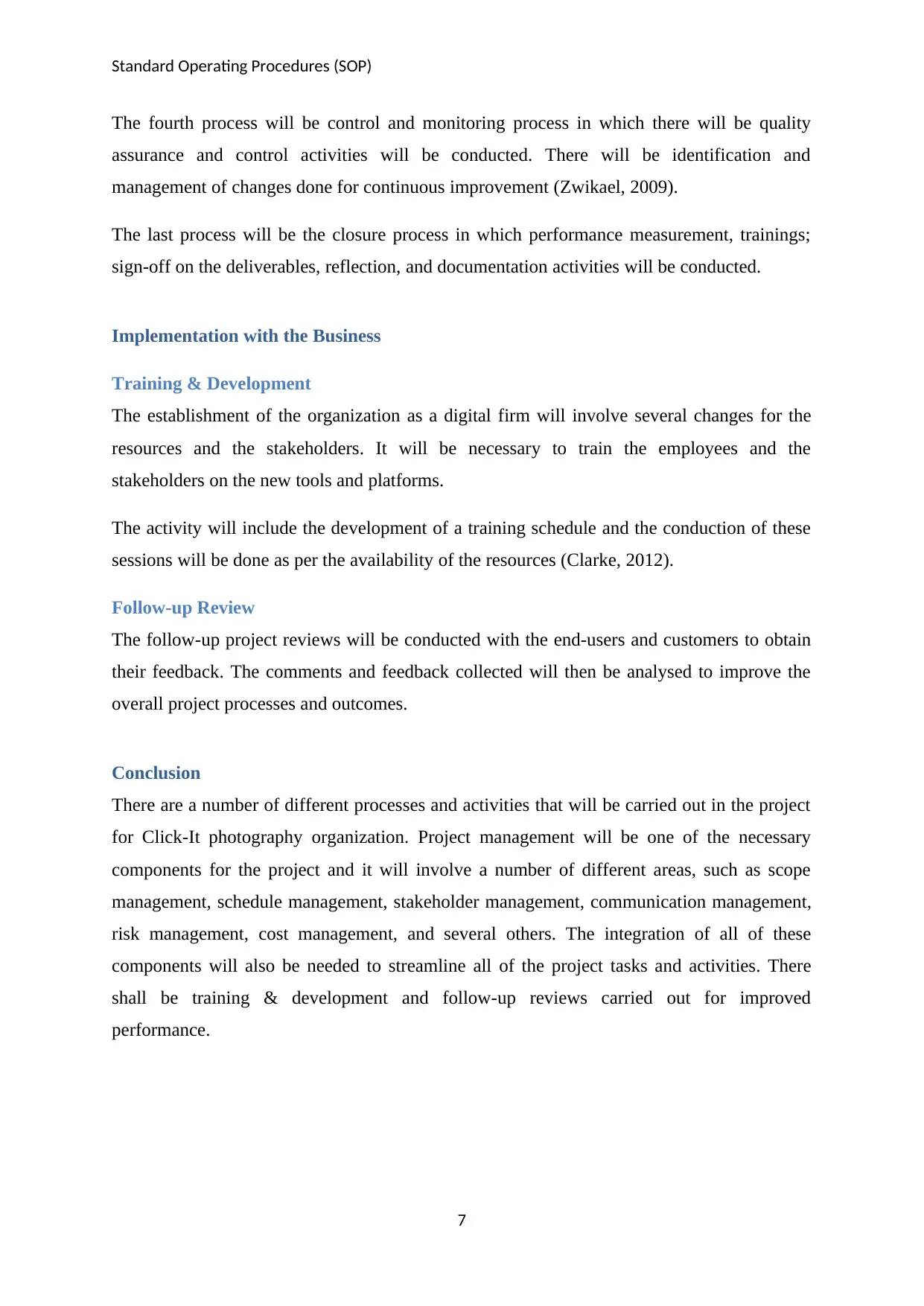
Standard Operating Procedures (SOP)
The fourth process will be control and monitoring process in which there will be quality
assurance and control activities will be conducted. There will be identification and
management of changes done for continuous improvement (Zwikael, 2009).
The last process will be the closure process in which performance measurement, trainings;
sign-off on the deliverables, reflection, and documentation activities will be conducted.
Implementation with the Business
Training & Development
The establishment of the organization as a digital firm will involve several changes for the
resources and the stakeholders. It will be necessary to train the employees and the
stakeholders on the new tools and platforms.
The activity will include the development of a training schedule and the conduction of these
sessions will be done as per the availability of the resources (Clarke, 2012).
Follow-up Review
The follow-up project reviews will be conducted with the end-users and customers to obtain
their feedback. The comments and feedback collected will then be analysed to improve the
overall project processes and outcomes.
Conclusion
There are a number of different processes and activities that will be carried out in the project
for Click-It photography organization. Project management will be one of the necessary
components for the project and it will involve a number of different areas, such as scope
management, schedule management, stakeholder management, communication management,
risk management, cost management, and several others. The integration of all of these
components will also be needed to streamline all of the project tasks and activities. There
shall be training & development and follow-up reviews carried out for improved
performance.
7
The fourth process will be control and monitoring process in which there will be quality
assurance and control activities will be conducted. There will be identification and
management of changes done for continuous improvement (Zwikael, 2009).
The last process will be the closure process in which performance measurement, trainings;
sign-off on the deliverables, reflection, and documentation activities will be conducted.
Implementation with the Business
Training & Development
The establishment of the organization as a digital firm will involve several changes for the
resources and the stakeholders. It will be necessary to train the employees and the
stakeholders on the new tools and platforms.
The activity will include the development of a training schedule and the conduction of these
sessions will be done as per the availability of the resources (Clarke, 2012).
Follow-up Review
The follow-up project reviews will be conducted with the end-users and customers to obtain
their feedback. The comments and feedback collected will then be analysed to improve the
overall project processes and outcomes.
Conclusion
There are a number of different processes and activities that will be carried out in the project
for Click-It photography organization. Project management will be one of the necessary
components for the project and it will involve a number of different areas, such as scope
management, schedule management, stakeholder management, communication management,
risk management, cost management, and several others. The integration of all of these
components will also be needed to streamline all of the project tasks and activities. There
shall be training & development and follow-up reviews carried out for improved
performance.
7
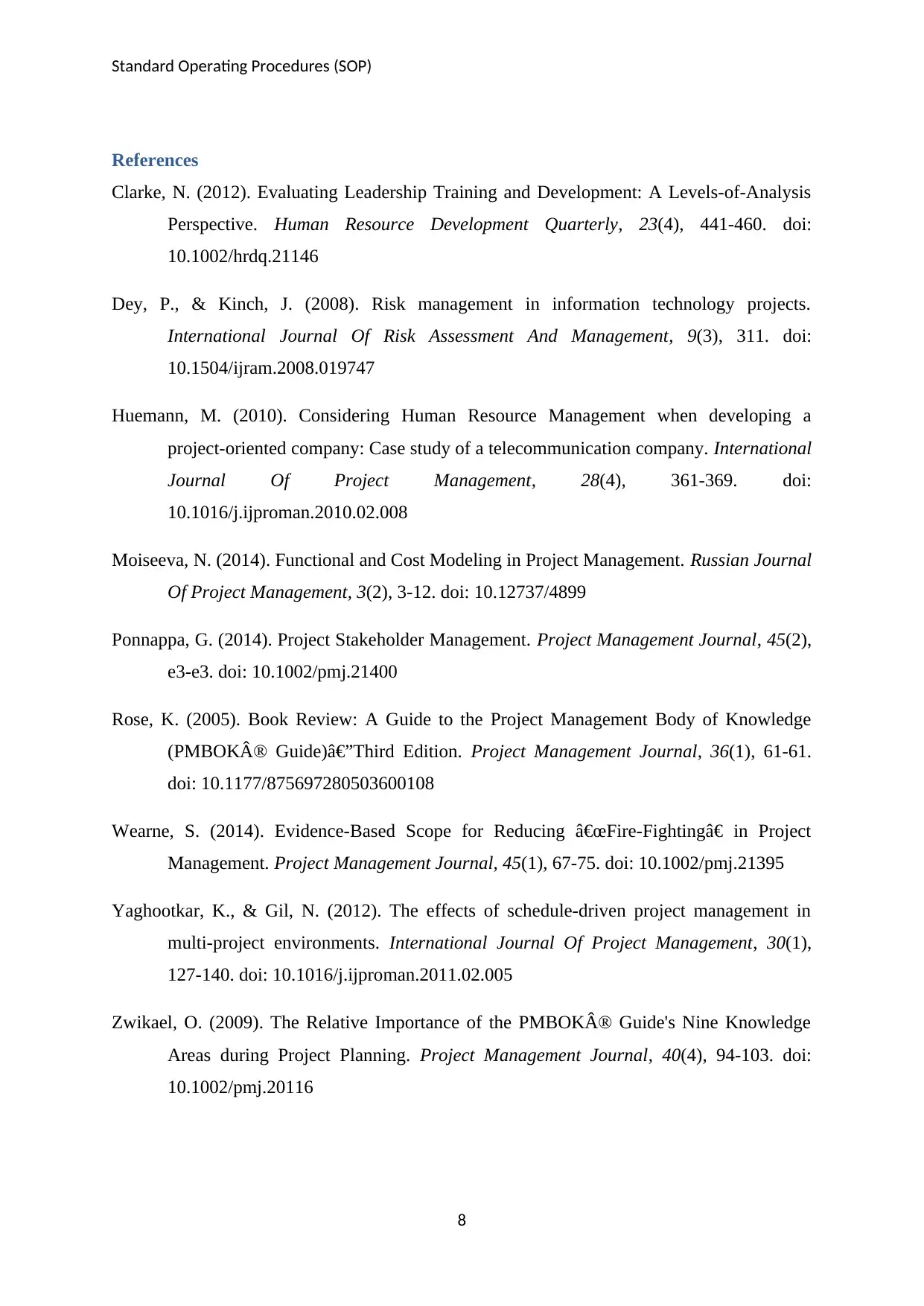
Standard Operating Procedures (SOP)
References
Clarke, N. (2012). Evaluating Leadership Training and Development: A Levels-of-Analysis
Perspective. Human Resource Development Quarterly, 23(4), 441-460. doi:
10.1002/hrdq.21146
Dey, P., & Kinch, J. (2008). Risk management in information technology projects.
International Journal Of Risk Assessment And Management, 9(3), 311. doi:
10.1504/ijram.2008.019747
Huemann, M. (2010). Considering Human Resource Management when developing a
project-oriented company: Case study of a telecommunication company. International
Journal Of Project Management, 28(4), 361-369. doi:
10.1016/j.ijproman.2010.02.008
Moiseeva, N. (2014). Functional and Cost Modeling in Project Management. Russian Journal
Of Project Management, 3(2), 3-12. doi: 10.12737/4899
Ponnappa, G. (2014). Project Stakeholder Management. Project Management Journal, 45(2),
e3-e3. doi: 10.1002/pmj.21400
Rose, K. (2005). Book Review: A Guide to the Project Management Body of Knowledge
(PMBOK® Guide)—Third Edition. Project Management Journal, 36(1), 61-61.
doi: 10.1177/875697280503600108
Wearne, S. (2014). Evidence-Based Scope for Reducing “Fire-Fighting†in Project
Management. Project Management Journal, 45(1), 67-75. doi: 10.1002/pmj.21395
Yaghootkar, K., & Gil, N. (2012). The effects of schedule-driven project management in
multi-project environments. International Journal Of Project Management, 30(1),
127-140. doi: 10.1016/j.ijproman.2011.02.005
Zwikael, O. (2009). The Relative Importance of the PMBOK® Guide's Nine Knowledge
Areas during Project Planning. Project Management Journal, 40(4), 94-103. doi:
10.1002/pmj.20116
8
References
Clarke, N. (2012). Evaluating Leadership Training and Development: A Levels-of-Analysis
Perspective. Human Resource Development Quarterly, 23(4), 441-460. doi:
10.1002/hrdq.21146
Dey, P., & Kinch, J. (2008). Risk management in information technology projects.
International Journal Of Risk Assessment And Management, 9(3), 311. doi:
10.1504/ijram.2008.019747
Huemann, M. (2010). Considering Human Resource Management when developing a
project-oriented company: Case study of a telecommunication company. International
Journal Of Project Management, 28(4), 361-369. doi:
10.1016/j.ijproman.2010.02.008
Moiseeva, N. (2014). Functional and Cost Modeling in Project Management. Russian Journal
Of Project Management, 3(2), 3-12. doi: 10.12737/4899
Ponnappa, G. (2014). Project Stakeholder Management. Project Management Journal, 45(2),
e3-e3. doi: 10.1002/pmj.21400
Rose, K. (2005). Book Review: A Guide to the Project Management Body of Knowledge
(PMBOK® Guide)—Third Edition. Project Management Journal, 36(1), 61-61.
doi: 10.1177/875697280503600108
Wearne, S. (2014). Evidence-Based Scope for Reducing “Fire-Fighting†in Project
Management. Project Management Journal, 45(1), 67-75. doi: 10.1002/pmj.21395
Yaghootkar, K., & Gil, N. (2012). The effects of schedule-driven project management in
multi-project environments. International Journal Of Project Management, 30(1),
127-140. doi: 10.1016/j.ijproman.2011.02.005
Zwikael, O. (2009). The Relative Importance of the PMBOK® Guide's Nine Knowledge
Areas during Project Planning. Project Management Journal, 40(4), 94-103. doi:
10.1002/pmj.20116
8
⊘ This is a preview!⊘
Do you want full access?
Subscribe today to unlock all pages.

Trusted by 1+ million students worldwide

Standard Operating Procedures (SOP)
9
9
1 out of 10
Related Documents
Your All-in-One AI-Powered Toolkit for Academic Success.
+13062052269
info@desklib.com
Available 24*7 on WhatsApp / Email
![[object Object]](/_next/static/media/star-bottom.7253800d.svg)
Unlock your academic potential
Copyright © 2020–2025 A2Z Services. All Rights Reserved. Developed and managed by ZUCOL.





